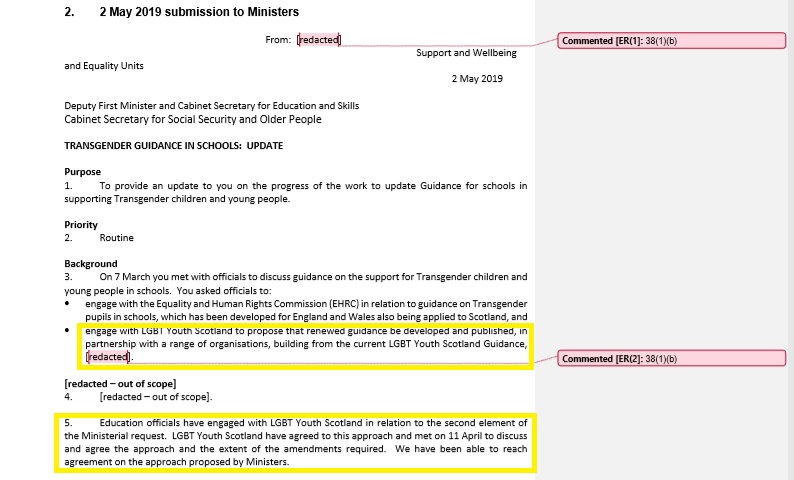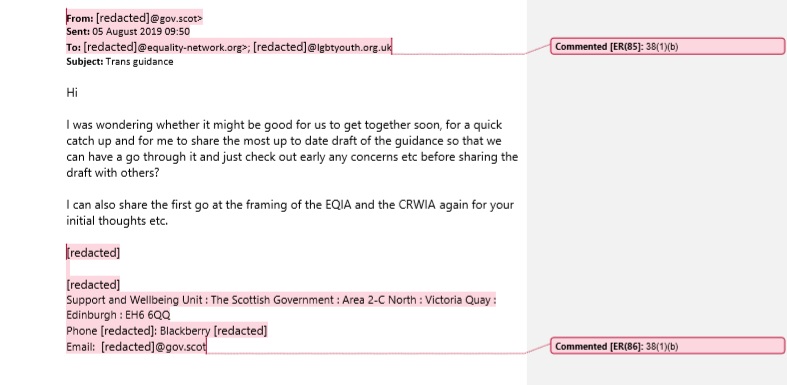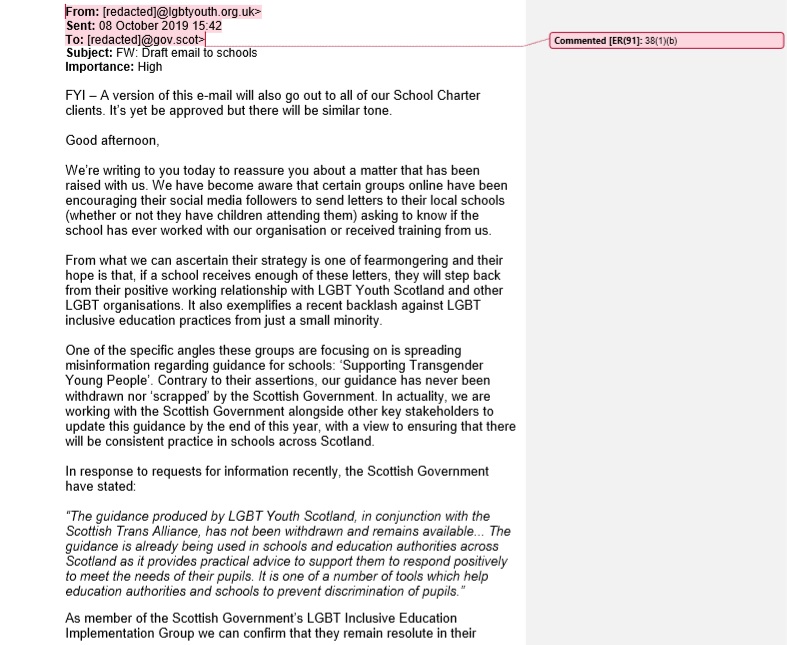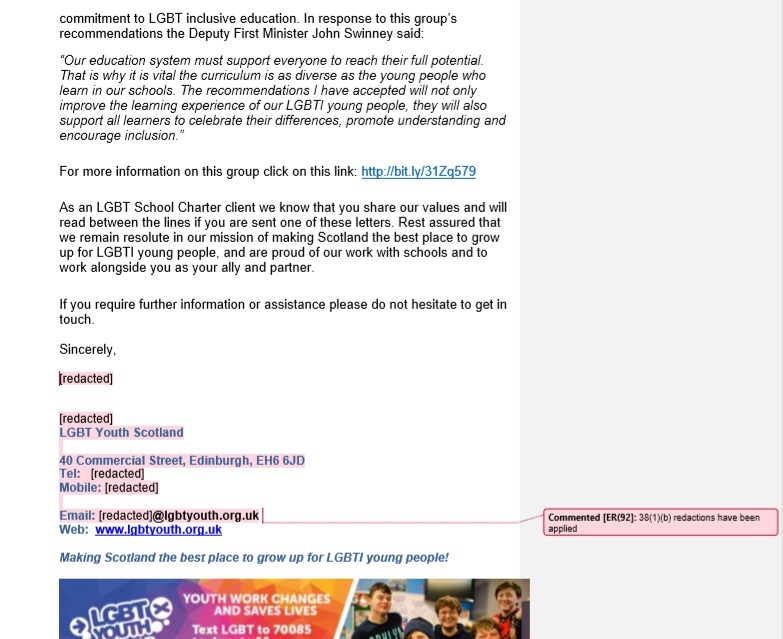LGBT Youth Scotland – Freedom of Information Request
In 2017, guidance for schools was published by LGBT Youth Scotland, entitled “Supporting Transgender Young People: Guidance for Schools in Scotland”. While its aim was to help schools support children who identify as transgender, the publication was heavily criticised for its failure to consider the specific rights and needs of girls and the negative impact that many of the recommendations made within the guidance would have on them. The production of the guidance was funded by the Scottish Government and it carries the Scottish Government logo prominently on its front cover. Despite this, the Scottish Government were reluctant to take any responsibility for the guidance stating, in response to the sustained criticism, that it would be inappropriate for them to review the guidance and that it had the full support of Ministers. However, in June 2019 the Scottish Government unexpectedly announced their decision to replace the LGBT Youth Scotland publication with guidance produced by the Scottish Government. This post explores the reasoning behind this decision, what we know about the development of the new guidance so far, and LGBTYS involvement.
A Freedom of Information request for information relating to the Scottish Government’s decision revealed the reasons for replacing the guidance:
On the 7th March 2019, Ministers had a meeting during which the decision was made to produce updated guidance. “The basis of this decision was Ministers’ view that guidance that risked potentially excluding other girls from female-only spaces was not legal.”
A briefing addressed to the Deputy First Minister and Cabinet Secretary for Education and Skills contained within the same Freedom of Information release noted the following concern about the LGBT Youth Scotland guidance: “Given the sustained criticism of the transgender guidance in the public domain there is risk of diminished confidence in the guidance should the negative criticism continue.”
This worry was shared by the Minister for Older People and Equalities, who voiced her concern that, due to the diminished confidence noted above, “teachers will not use the guidance”.
The Scottish Government therefore took the decision to replace the LGBT Youth Scotland guidance because confidence in it was diminished, it risked excluding girls, and it was not legal.
A new Freedom of Information request reveals some of what has happened since this decision was made. A submission to Ministers outlines the Scottish Government’s intentions with regards to the replacement guidance. Government officials were instructed to: “engage with LGBT Youth Scotland to propose that renewed guidance be developed and published, in partnership with a range of organisations, building from the current LGBT Youth Scotland Guidance.”

This engagement was successful, with the same submission reporting that: “ LGBT Youth Scotland have agreed to this approach and met on 11 April to discuss and agree the approach and the extent of the amendments required. We have been able to reach agreement on the approach proposed by Ministers.”
So although LGBTYS produced guidance that risked excluding girls and was described as “not legal”, the Scottish Government still sought their agreement to replace it, and despite the fact that one of the reasons for its replacement was diminished confidence, the Scottish Government still want to the new guidance to be “building” from the original.
The LGBTYS school guidance is hosted on the Education Scotland National Improvement Hub, an online resource which provides teachers with information and support to improve the quality of learner’s experiences, such as exemplars of good practice and teaching resources. On 10th May 2019, a full two months after the decision was taken to replace the guidance, the Deputy First Minister issued a letter to education authorities encouraging them to “build on existing good practice”. This letter contained a link to ‘good practice’ resources on the Improvement Hub, the first of which was (and still is) the LGBT Youth Scotland guidance.
Then in August, in email correspondence with LGBT Youth Scotland, the Government’s Support and Wellbeing Unit wrote the following: “I was wondering whether it might be good for us to get together soon, for a quick catch up and for me to share the most up to date draft of the guidance so that we can have a go through it and just check out early any concerns etc before sharing the draft with others? I can also share the first go at the framing of the EQIA and the CRWIA again for your initial thoughts etc.”

The Scottish Government have not only been sharing and reviewing the draft guidance with LGBT Youth Scotland, they have also been sharing and reviewing their Equality and Children’s Rights and Wellbeing Impact Assessments of the guidance. It is not clear what expertise the Government is seeking from LGBT Youth Scotland with regards to impact assessments, given LGBTYS previous lack of engagement with impact assessment as a process for taking into account the needs of all. Perhaps they are consulting to make sure that all possible impacts on LGBT people have been considered by the EQIA and CRWIA. In which case, they will presumably be consulting with other organisations which can provide similar expertise about the interests of other protected groups, such as girls. But is there any organisation in Scotland which will represent the interests of girls on this issue?
To date, the only mainstream organisation that has publicly challenged the LGBTYS school guidance has been the office of the Children and Young People’s Commissioner Scotland, by recognising the concerns and the need for guidance used by schools to be compliant with domestic and international law, and that consequently “further work must be done” with regards to the LGBTYS guidance. However, the LGBTYS guidance still carries the CYPCS logo of endorsement. Also still listed as endorsing the guidance are Barnardo’s, Together, Children in Scotland, Respect Me, NHS Lothian, Glasgow Health and Social Care Partnership among others, as well as 16 local authorities.
According to the Scottish Government, this guidance risked excluding girls and the misinformation it contained was extensive enough for it to be described by the Scottish Government as “not legal”. Public criticism was to such an extent that the Scottish Government was concerned about diminished confidence and that teachers would not use it. It has been deemed so unfit for purpose that rather than being amended, it is to be replaced.
In spite of all this, not one of the organisations which endorsed the guidance has publicly commented on their failure to notice the negative impact of the guidance on girls. Not one has commented on their continued endorsement. No publicly funded or third sector organisation in Scotland has ever spoken in defence of the interests of girls in relation to the issue of transgender inclusion in schools (or anywhere else), including those organisations whose remit is women and girls and the issues that affect them.
This could be because LGBT Youth Scotland has trained them all.
In their 20017/18 Annual Progress Report, completed after receiving a £260,000 grant, and their application form for this grant, LGBTYS detail all the organisations they have worked with during this time period.
They have held meetings and contacted the following organisations to “increase their understanding” of the proposed changes to the Gender Recognition Act: Children in Scotland, CLAN Child Law, the Children and Young People’s Commissioner for Scotland, the Scottish Youth Parliament, and Barnardo’s. They have developed a ‘charter’ programme focussing on training and reviewing policies, practices and resources within organisations to help them become more LGBT inclusive. Schools are targeted specifically for this programme, 60 during this grant period. 25 other organisations were awarded the ‘Charter Mark’ including the General Teaching Council for Scotland, the Care Inspectorate, youth agencies, health services, North Lanarkshire Children and Family Service, colleges and universities and local councils. Children’s sector organisations that have signed up for the training and policy review process are Children in Scotland, Young Scot, The Scottish Youth Parliament and Children First, with 70 staff receiving training. In addition LGBTYS supported 12 Gender Based Violence organisations to undertake the Charter with 4 receiving the award: Ross-Shire Women’s Aid, Women’s Aid South Lanarkshire and Renfrewshire, Dundee Women’s Aid and Scottish Border’s Rape Crisis. LGBTYS also engages with COSLA, EIS, School Leaders Scotland and the National Parent Forum. They have delivered seminars to HMI Inspectors. They have worked within 6 of the 8 teaching Universities in Scotland reaching more than 1,500 of the next cohort of teachers and childhood practitioners. LGBTYS are a managing partner of respectme, working alongside SAMH and they hold regular meetings with Childline and ParentLine Scotland.
All of these organisations have potentially received advice, education or training from LGBT Youth Scotland that, like the guidance, risks excluding girls and is not legal. How many more might have received this since 2018?
In this climate, it has been ordinary women who have been the ones to notice and raised the alarm. Driven by the negative experiences their daughters were reporting and deep concern for the predicament of girls in schools using the LGBTYS guidance, they have banded together in grassroots groups and written to their children’s schools to protest its implementation. Now vindicated by the replacement of guidance which they understood to be harmful while those who are publicly funded to protect children from harm seemingly did not, they have persisted in investigating whether schools are still using it or the recommendations it contains, either directly or indirectly through workshops or training from LGBTYS.
What has been the reaction of LGBTYS to these concerned women? Humility at having produced guidance for schools which was “not legal”? An apology for risking the exclusion of girls? Assurances that current training for schools is being revisited in light of the guidance being replaced? Of course not.
This is an email from LGBT Youth Scotland to the Scottish Government, outlining a communication to be sent out to LGBTYS “School Charter clients” – schools which have received training from LGBTYS in order to help them be more LGBT inclusive.
FYI – A version of this e-mail will also go out to all of our School Charter clients. It’s yet be approved but there will be similar tone.
Good afternoon,
We’re writing to you today to reassure you about a matter that has been raised with us. We have become aware that certain groups online have been encouraging their social media followers to send letters to their local schools (whether or not they have children attending them) asking to know if the school has ever worked with our organisation or received training from us.
From what we can ascertain their strategy is one of fearmongering and their hope is that, if a school receives enough of these letters, they will step back from their positive working relationship with LGBT Youth Scotland and other LGBT organisations. It also exemplifies a recent backlash against LGBT inclusive education practices from just a small minority.
One of the specific angles these groups are focusing on is spreading misinformation regarding guidance for schools: ‘Supporting Transgender Young People’. Contrary to their assertions, our guidance has never been withdrawn nor ‘scrapped’ by the Scottish Government. In actuality, we are working with the Scottish Government alongside other key stakeholders to update this guidance by the end of this year, with a view to ensuring that there will be consistent practice in schools across Scotland.
In response to requests for information recently, the Scottish Government have stated:
“The guidance produced by LGBT Youth Scotland, in conjunction with the Scottish Trans Alliance, has not been withdrawn and remains available… The guidance is already being used in schools and education authorities across Scotland as it provides practical advice to support them to respond positively to meet the needs of their pupils. It is one of a number of tools which help education authorities and schools to prevent discrimination of pupils.”
As member of the Scottish Government’s LGBT Inclusive Education Implementation Group we can confirm that they remain resolute in their commitment to LGBT inclusive education. In response to this group’s recommendations the Deputy First Minister John Swinney said:
“Our education system must support everyone to reach their full potential. That is why it is vital the curriculum is as diverse as the young people who learn in our schools. The recommendations I have accepted will not only improve the learning experience of our LGBTI young people, they will also support all learners to celebrate their differences, promote understanding and encourage inclusion.”
For more information on this group click on this link: http://bit.ly/31Zq579
As an LGBT School Charter client we know that you share our values and will read between the lines if you are sent one of these letters. Rest assured that we remain resolute in our mission of making Scotland the best place to grow up for LGBTI young people, and are proud of our work with schools and to work alongside you as your ally and partner.
If you require further information or assistance please do not hesitate to get in touch.”


So according to LGBTYS, women are writing to ask schools if they have ever worked with LGBTYS or received training from them, and this is because these women have a strategy of “fearmongering”. Women who are concerned about the use of guidance which risks excluding girls and the training given by an organisation which has produced guidance which has not been legal, are fearmongering.
LGBTYS take great pains to point out the “misinformation” that is being spread. Not the gross misinformation contained within their guidance which was so extensive as to render it not legal, but rather the more serious misinformation being perpetuated by concerned mothers – that the LGBTYS guidance has been “withdrawn”. It has of course not been withdrawn but is merely being replaced to ensure “consistent practice” – consistent practice in this case presumably referring to consistency with the law. Finally, LGBTYS “know” that schools “will read between the lines” if they receive a letter from a worried parent. LGBT Youth Scotland are openly encouraging schools not to respond in good faith to those with concerns, but instead asking schools to ascribe an ill-intentioned motivation of which even LGBTYS acknowledge that there will be no evidence of (as schools will have to “read between the lines” in order to find it).
All of this points to a deeply troubling situation. There is a near complete abandonment by women’s and children’s organisations to stand up for the interest and rights of girls on the issue of transgender inclusion. The only people who have been willing to do so have been ordinary women who, in a David and Goliath fashion, have succeeded in making their concerns about the LGBTYS guidance heard and proven legitimate. Despite this, LGBTYS is still asserting that it is in fact these women who are spreading misinformation, who are fearmongering and whose concerns should not be taken seriously even if they seem legitimate, and who are so confident that this characterisation and behaviour is acceptable to their primary funders, the Scottish Government, and the schools they work with that they happily send this off to them in writing.
With a lack of humility, failure to take responsibility, and persistence in smearing women whose concerns have been found valid, the LGBTYS brand is becoming increasingly toxic. The Scottish Government are right to have recognised that the original LGBT Youth Scotland guidance has suffered from diminished confidence due to sustained public criticism. What they have failed to recognise is that if the replacement guidance does not depart significantly from the LGBTYS original to demonstrate sufficient consideration for the privacy, dignity and safety of girls, then the same fate awaits it.
